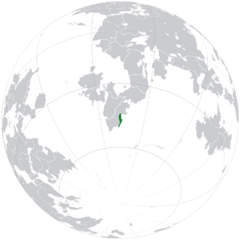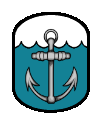Costak
Costak Costak | |
|---|---|
 | |
| Capital and | Sevrak |
| Other languages | Costakian, Morrawian, German |
| Religion | Novo Christianity/Novoism, Atheism, Protestantism, Catholicism, |
| Demonym(s) | Costakian |
| Government | Social Democratic Theocracy |
• Saint | Zoya |
• Chancellor | Boris |
| Area | |
• | 76,864 km2 (29,677 sq mi) |
| Population | |
• Estimate | 5.426 million |
• Density | 70.6/km2 (182.9/sq mi) |
| GDP (PPP) | estimate |
• Total | 213 bllion |
• Per capita | 39,368 |
| Time zone | UTC+5 |
Costak, officially the Costakan Sovern States, is a country located in the far South West of Olivacia, a major portion of its population is centered around the capital of Sevrek with a substantial amount also being found in the Svyaz agricultural lands. The nation borders the Kaldaz Ocean which also plays a major role in the nation's history, culture and economy. Among the nations five states live a population of 5.426 million people.
Etymology
The name Costak comes from a combination of words from the Slavic language of Costakian. It combines the word for coast, that being "cost" alongside the word "parak" which means port. The reason for the nation, in essence, being called "port coast" is due to its orgins as a union between costal cities in the region before it was expanded to the Northern mountains.
Language
While common and a few other languages are also spoken across Costak due to immigration, Costakian remains the most spoken in the region. Costakian is a primarily Slavic language, with Costak's first settlers being those who sailed from Slavic lands in the West. There is however also influence from other languages such as common due to Costak's more local neighbors.
History
Pre 1000 AC
Costak's history before roughly 1000 AC remains largely a mystery, it is presumed that a native people inhabited the area in small numbers before this date, however it is also believed that these people were wiped out by foreign diseases with the arrival of the Western Slavs.
Early Costakians and The Kingdom of Costak (1000 - 1670)
Slavic people from the South West of Thrismari, explorers, traveled across the Kaldaz ocean and reached the South West of Olivacia. These people lived off the land for a while before reaching the modern day Sevrek and Svyaz regions which were optimal for settling in small populations thanks to their temperate weather, fertile soil, and seaside position allowing for fishing. A kingdom was eventually established in roughly 1200. The region also remained fairly defendable thanks to the Northern mountains.
The Imperial Protectorate of Costak (1671 to 1845)
As the colonial era began, the at the time king of Costak, Vadim Ivanov realized that the minor nation with its small industry, population, and military, would be unable to fully resist an invasion from a colonial power. With this realization, the king looked to Morrawia for aid and made an agreement in 1671. The royal family of Costak would become puppet rulers loyal to Morrawian interest, and in exchange, Costak would keep a level of autonomy and gain protection from other colonial powers. While Costak enjoyed a greater level of autonomy than other colonies at the time, they would still be required by the royal family to allow free immigration and settling from Morrawia, docking rights in ports, as well as much, much lower prices when trading resources to Morrawia. Primarily due to the economic parts of this agreement, Costak's economy would begin to struggle during this period, with a large portion Costakians being fairly poor though still able to afford cost of living. Rural regions such as those in the Svyaz regions were hit particularly hard by the economic hardship, meanwhile some cities like Suyug did even see some minor economic growth in the period thanks to Morrawian settlers.
First true independence (1846 to 1856)
During a time of instability in Morrawia, Costak would quickly begin to attempt to take the opportunity to gain liberties that had been desired for much of the nation's colonial history. This was aided by new ideas in religion, with reformed Christianity known as Novo Christianity or Novoism quickly rising in popularity in the country due to its more relaxed and inclusive polices that ensured less power in the church and king while also promising more rights for groups such as women due to the belief that within the Bible, God had become far more loving and merciful with the arrival of Jesus Christ. This combined demand for both new religious ideas, increased religious freedom, and more liberties alongside Morrawian instability led to a combination of violent and non-violent protests which would eventually lead to the drafting of a constitution and the king being forced from power. The new constitution required that the king instead be elected and be called a chancellor, ruling alongside a democratically elected religious leader known as a saint who would manage religious matters. While the constitution put many restrictions on these leaders, they still had few other people in power to restrict their power. While many were very happy with the new liberties gained, Costak still struggled during this period. While democratically elected, lack of restrictions on the two government leaders raised concerns and increased instability in the newly freed nation. Additionally, the nation struggled economically without Morrawian aid, despite independence, still keeping many rural citizens poor due to lack of centralization and transportation in the inner regions. This sent much of the nation into a struggling depression, with a poor economy and lack of infrastructure. Even regions like Suyug that had finally seen economic growth began to return to being a poorer region as many of the richer Morrawian settlers in the region returned to their home nation.
The Incorporated Autonomous Territory of Costak (1857 to 1906)
Following the economic struggles and depression of the new Nation, it began searching for a way out of its issues. The recently elected chancellor looked to the now democratic colonizer and considered yet another deal with the nation, similar to the agreement of 1671, however now Costak pushed for even greater autonomy. A deal was signed, it similarly again allowed things like docking rights in ports and Morrawian settlers, as well as discounted trade between the two nations, however the discounts were now much less extreme. Under the agreement, the chancellor of Costak would also have to be approved by both a Costakian election of Costakian citizens as well as a vote from the Morrawian Federal Congress. There was a lot of controversy around the reunion of the nations; many were hopeful of future economic growth, while many others were skeptical and worried that it would further send the nation into economic collapse while also restricting freedoms that were just recently gained. Thankfully, as a whole, the hopeful were correct. The nation once again saw settlers, slowly resettle major cities like Suyug and Sevrek in increasing numbers. Additionally, investments and the construction of major railways and roads led Costak quickly growing economically. The nation would find new niches in sects like machinery, vehicles (such as trains, ships, and later cars), and electrical equipment. The previous major economic sects such as fishing, agriculture, and base metals also saw major growth. Agriculture particularly saw a lot of growth with infrastructure allowing the goods to be transported for trade. Base metal trade also major growth, though less than agriculture. This was once again thanks to increase infrastructure, better connecting the mines of the Goralya mountains to ports like Gorak. Economic growth would begin to slow down by the early 1900s. Many Costakians were still well off by this point, but the nation largely began to see the restrictions caused by the discounted trade and requirement of leaders to have Morrawian approval. However, many were still in favor of Morrawia for their aid in bringing them out of the depression. This left very few calling for a revolution for freedom, however many still desired it by some means. As the great War began, the chancellor of Costak saw an opportunity. Costak began working out an agreement with Morrawia in which full independence would be gained in exchange for full independence. The agreement was made, Morrawia seeing it as a way of keeping trade and allianceship with Costak while also gaining aid in an important time.
The Great War (1907 to 1911)
Due to Costak's small size and population, the nation quickly focused its efforts on production. Using its base metals, the nation would quickly focus industrial efforts on arms production and convoys. The nation would also produce a very small number of war ships which it would man to support Morrawia. Despite Costak's very low manpower, the nation would also quickly mobilize a military. The nation managed this largely due to propaganda campaigns which supported the idea of a fight for democracy and full freedom from Morrawia. The nation mobilized two divisions, one which was fairly small and focused on defending the nation from any naval invasions, the other which was a bit larger and would fight alongside Morrawian divisions during the Great War. The nation would also provide humanitarian aid to Morrawia in the form of agriculture produced.
Second true independence (1912 to 1924)
Following victory in the Great War, Costak began recovering from the battle and also preparing for full independence from Morrawia. In 1922, a new constitution was ratified and Costak officially cut all colonial ties with Morrawia. The nation established a largely direct democracy that still kept a chancellor and saint. However, the chancellor and saint had greatly reduced powers, both primarily acting only to propose laws to be voted on rather than establishing laws themselves. The categorical roles however still remained the same, with the chancellor and their cabinet proposing general laws and policies while the saint proposes religious laws and policies. The nation, now free from any international influence, quickly began to once again see economic growth. The econmic sects that thrived during the Incorporated Autonomous Territory of Costak Era once again thrived with the introduction of more free trade. By this point, many Morrawian settlers had become content with the nation, most now staying in the newly free country. States also saw greater autonomy in this new era, being more liberal in what laws may be passed on a state by state basis.
The Novoism Golden Age. (1925 to 1950)
After gaining independence, Novoists, who made up most of the population, saw a great resurfacing in their beliefs during this era. Now free from Morrawian influence, the progressive ideals thrived under a democracy of majority Novoists. Policies providing better protection for equality quickly began to surface thanks to the election of Novoist chancellors.
Geography
Environment
Administrative divisions
There are five semi-autnomous states within Costak, from North to south, these are Goralya, Greater Sevrak, North Svyaz, South Svyaz, and Dalekalya
Demographics
TBA
Economy
TBA
Economy
TBA


